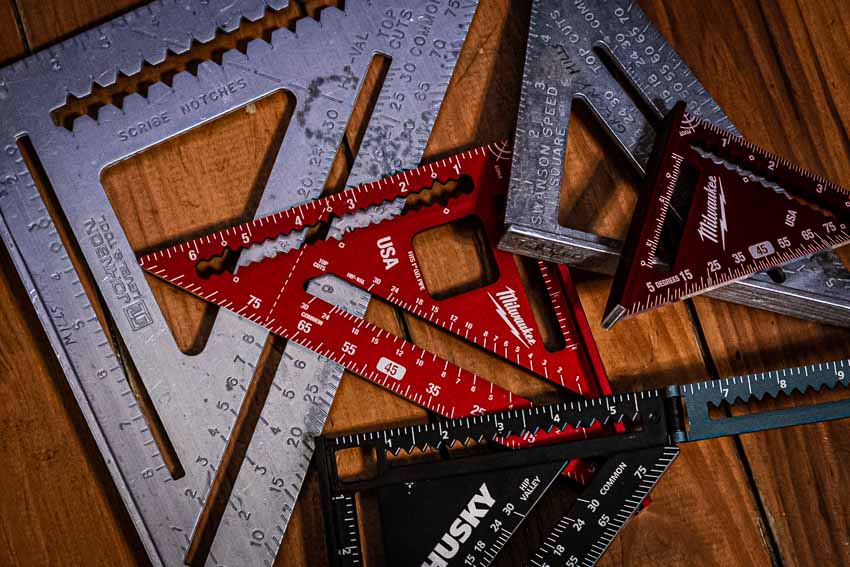Let’s go ahead and get this out of the way. Swanson Tool Company (link) invented the term Speed Square and made the first such tools. Though they dislike it when people use the term generically, it’s too late. The name stuck, rather like Kleenex or Sawzall. Technically, these tools are called rafter squares or some people call them triangle squares. Most people call them “speed squares”, though (in lowercase). We’ll use that vernacular in this article as well. There are many tricks to using a speed square. Here are just the most important ones with the exception of laying out roof rafters. That falls beyond the scope of this article.
Table of Contents
- Types of Speed Squares
- 1. How to Use a Speed Square as a Protractor
- 2. Setting Miter Saw Angles
- 3. How to Make Straight Cuts Using a Speed Square as a Guide
- 4. Use a Speed Square to Set the Blade on Your Table or Circular Saw
- 5. Using the Speed Square as a Marking Gauge
- 6. Using the Speed Square as a Height Gauge
- 7. Use a Speed Square as a Level
- Other Markings on a Speed Square
- Conclusion
Types of Speed Squares
Speed squares are typically made of either plastic or aluminum. The plastic ones are lightweight and give you high visibility. They just don’t last as long as the aluminum ones. The plastic speed squares are non-marring and ideal for use on painted surfaces like siding.
For a few dollars more you can get aluminum speed squares. These will literally last you a lifetime. Swanson made the original, but Irwin makes one that is excellent for poor eyesight or dark conditions. The beautiful Milwaukee rafter square is extremely accurate, and they also make a 4 -1/2” trim square that I especially like when using 2x4s. Many companies make a 12” model. I use this size most often as a saw guide—more on that later.
Husky and Crescent makes a 6” triangle square which they call a 2-in-1 Extendable Layout Tool. This rafter square with an extension arm that flips out, extending it to 12”. They appear to be identical except for the color. I bought one and it was off by 1/64”. It did not matter if it was open or closed, it was still out of square. I read the reviews on Amazon and some others reported theirs was not square either.

1. How to Use a Speed Square as a Protractor
The most obvious use of a speed square is for marking 90 and 45 degrees. The speed square is in fact, also a protractor. Protractors and speed squares measure the angles a little differently, though. Take a look at the photos below. With the protractor, 0 degrees is horizontal and works up to 90 being straight up. With a speed square, 0 degrees is vertical. To deal with this, we use a quick workaround.

To use the rafter square as a standard protractor, simply pivot the tool until the indicated angle equates to whatever measurement you need subtracted from 90. This means if you need a 60-degree angle as shown below you use 30 degrees on the rafter square.

2. Setting Miter Saw Angles
By now you may be asking yourself, “why do I have to do this math?” Good news! When cutting boards, you don’t. The angles on a speed square match up with the angles on your miter saw—which are also based on 0 degrees being vertical. Therefore, a 30-degree cut on the miter saw is simply a 30-degree line on the speed square. Make your mark, then make your cut.
3. How to Make Straight Cuts Using a Speed Square as a Guide
In my opinion, perhaps the single most important use of the speed square is helping you make straight cuts. To use a speed square as a saw guide, start by marking the line you intend to cut across a board at either 90 or 45 degrees. Now put your saw so the teeth of the blade are lined up with the cut line. Hold the speed square against the saw’s shoe as a fence as shown in the photo. Make sure you keep your space between the saw blade and the cut line consistent.
While a 6” model works just fine for this, I prefer to use a 12” speed square. The extra length gives the saw more fence to ride against.

4. Use a Speed Square to Set the Blade on Your Table or Circular Saw
Place the square on your saw with the T-edge down so it free stands. Now raise the table saw blade all the way and adjust the angle so it matches the triangle square when you need either 45 or 90-degree angled cuts. We also use squares to ensure our table saw fence is square. Finally, you can adjust your circular saw using the same method as the table saw blade.

5. Using the Speed Square as a Marking Gauge
Many rafter squares have a series of sawtooth notches on them. These are designed so you can put your pencil in them and scribe a line down a board at a set distance. The V shape acts as a guide for your pencil to ride in while you slide your square down to the board. Just hold the fence of the speed square tight against the wood as you move.

6. Using the Speed Square as a Height Gauge
Your speed square works as an excellent blade height gauge for your table saw or router table. Some squares do not have fine enough markings for this to be very accurate. Others, like the one from Milwaukee, are very precise. To use this method, stand the square upon its T-edge so it free stands. Use the scale on the 90-degree leg of the triangle to adjust the height of the blade or bit.
7. Use a Speed Square as a Level
In a pinch, you can use your square as a level. All you need is either a plumb bob or a string with a weight. A nut will do. Hold the plumb bob string at the pivot point with the widest part of the triangle facing down. The triangle will be level when the string is at 45 degrees.

Other Markings on a Speed Square
The brilliant feature of the original Swanson Speed Square design was the addition of jack, valley, and hip rafter scales. Each brand of the square has tried to put its own mark on it and make its own improvements. My Swanson is so old, it does not have the saw tooth notches for use as a marking gauge. Another company added that and Swanson then added it to their product. Some companies put common rafter conversion tables on their speed square.
The most unique feature of any of them is found in Milwaukee. It has a rectangular opening designed to be used as a saw stand for cutting pipe. Slip the end of your pipe through the rectangle and put the speed square on the ground and it will hold the pipe up while you make your cut. Eventually, this could damage the long edge of the square as it bounces around and gets nicks and chips in it. I might avoid regularly using this feature and buy a real stand like this one that also clamps down on 2x4s.

Trueing Up a Speed Square
Fortunately, I was able to true the square back to 90 degrees with a file. Here is a quick tip- Aluminum clogs files very quickly. Rub your file with chalk before you file the aluminum and it will act as a lubricant to keep it from clogging. If you are not comfortable with your skills with a file, tape a piece of sandpaper to your bench. Then you can work the speed square back and forth over the sandpaper applying more pressure on the side that needs to be removed to bring it into square.
Placed the out of square, square back to back with a known accurate square. You also want to place them both on a piece of clean flat glass. In my case, I used a freshly cleaned glass stovetop. Next, turn on a light behind the squares. If the squares are touching and light is coming through, one of them is out of square. If no light is coming through, they are perfectly square.

Conclusion
Whether you call them speed squares, rafter squares, or triangle squares, they get the job done and do it well. This versatile tool has a place in any toolbox even if you never use it to build a roof. You may also want to check out our article on how to measure and mark wood using a tape measure.



